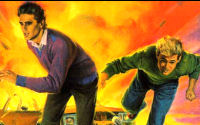

Revisions (Canon)
Beginning in 1959, the first 38 volumes were systematically revised. This massive project, completed in 1973, was directed by Harriet Adams, Edward Stratemeyer's daughter. The revision project had numerous results:
- Shorter books (180 pages instead of 225, 20 chapters instead of 25)
- Streamlined writing style (sometimes at the cost of humor, charm, and believability!)
- Elimination of racial stereotypes (for the most part)
- Modernization (no more roadsters and automats)
- Consistency of premises (Frank and Joe no longer gradually age from 15/16 to 17/18)
- Consistency of interior layout (the same typeface is used in all revised books)
- Newfound respect for officers of the law
- Deflation of Aunt Gertrude's character

This page provides (1) a timeline of the revision process, (2) an overview of the types of revisions that were carried out -- some books were only lightly edited, while others were completely rewritten -- and (3) a list of the ghostwriters and editors of the revised editions. For a discussion of the literary aspects of the revisions (themes, stereotypes, vocabulary, etc.), see the themes in revisions page, in the "literary info" section of the site.
Revision timeline (chart)
The following chart illustrates the publication year for the original and revised editions of each volume. Click the preview below to view the full-size chart (opens in a new window or tab).

Revision timeline (list)
- 1959
- Volumes 1 and 2
- 1960
- No revisions
- 1961
- Volume 14
- 1962
- Volumes 3, 4, and 11
- 1963
- Volume 5
- 1964
- Volumes 6, 7, and 19
- 1965
- Volumes 9, 12, and 16
- 1966
- Volumes 8, 17, 24, 27, and 37
- 1967
- Volumes 10 and 13
- 1968
- Volumes 15, 29, and 30
- 1969
- Volumes 18, 25, 31, and 32
- 1970
- Volumes 20, 21, 23, 26, 28
- 1971
- Volumes 22, 33, and 34
- 1972
- Volumes 35 and 36
- 1973
- Volume 38
Revisions by type
The degree and type of revisions varied. I've grouped them into four categories, in increasing order of severity:
- Same story, same text: Most of the original text remains intact, with pieces cut or slightly altered here and there (example: The Phantom Freighter).
- Same story, new text: The basic framework of the plot is the same, but the text has been completely (or almost completely) rewritten (example: The Tower Treasure).
- New story, old ideas: The book has been completely rewitten, and the plot is not the same, but some elements are retained, such as names, capers, episodes, or locations. (Examples: The Twisted Claw retains many elements, such as the Parrot freighters, the pirate empire, and the Caribbean island. The Sinister Signpost retains the racehorse named Topnotch and Aunt Gertrude's inheritance of a stable of racehorses, but their relevance to the story is completely changed.)
- Completely new story: The book has been completely rewitten and shares no elements with its predecessor (example: The Flickering Torch Mystery).
To appear soon: A list of which books fit into which category.
Revisions by ghostwriter
To appear soon: A list of who revised which book.
